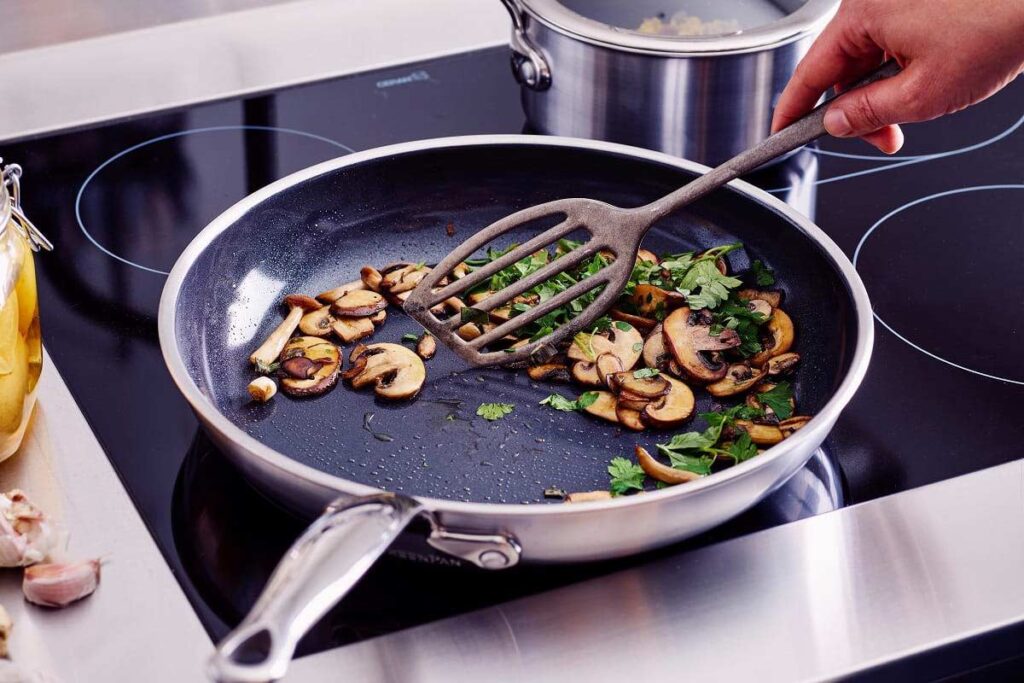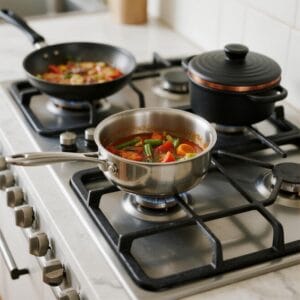Choosing the right cookware material can be challenging. The wrong choice could lead to uneven cooking, frequent maintenance, or even premature replacement. So, what’s the best cookware material?
Triply cookware, with its three-layer design, combines stainless steel’s durability with aluminum’s heat distribution for efficient, long-lasting performance. This blend ensures even cooking, easy maintenance, and versatility, making it an ideal choice for home and professional kitchens.
To fully understand why Triply stands out, let’s compare it with other popular cookware materials, and see how they measure up for different cooking needs.

What Key Factors Should You Consider in Cookware Materials?
When selecting cookware, understanding what you need from your cookware material is essential. Here are the key factors to consider:
1. Heat Conductivity: A material with good heat conductivity heats evenly, reducing hot spots and ensuring more consistent cooking.
2. Durability: Cookware should withstand daily use without warping, scratching, or degrading over time.
3. Non-Reactivity: Some materials can react with acidic foods, which can impact flavor and appearance. Non-reactive materials, like stainless steel, prevent this issue.
4. Ease of Cleaning: Low-maintenance cookware materials that resist staining and require minimal upkeep make clean-up easier.
5. Weight: Some materials, like cast iron, are heavy, which may not suit everyone. Lightweight materials offer easier handling.
Knowing these factors will help you make a more informed choice that fits your cooking style and needs.
What Are the Pros and Cons of Common Cookware Materials?

Here’s a closer look at the most popular cookware materials, each with its own strengths and weaknesses:
Stainless Steel
• Pros: Durable, non-reactive, and rust-resistant, making it versatile for a wide range of cooking.
• Cons: Poor heat conductivity on its own, often requiring additional core materials, like aluminum, to improve performance.
Stainless steel is a favorite for general-purpose cookware because of its durability and ease of cleaning. However, its heat conductivity is limited unless layered with other materials.
Aluminum
• Pros: Lightweight, heats quickly, and is affordable.
• Cons: Prone to scratching, warping, and can react with acidic foods unless anodized.
Aluminum’s quick heating and lightweight nature make it ideal for fast-cooking tasks. However, it’s less durable and can be reactive unless anodized for added resilience.
Copper
• Pros: Exceptional heat conductivity, ideal for precise temperature control.
• Cons: Expensive, requires frequent maintenance, and can react with acidic foods unless lined.
Copper is popular among professional chefs for its rapid, even heating and precise temperature control, though it requires more maintenance and comes with a higher price tag.
Cast Iron
• Pros: Great heat retention and naturally non-stick when seasoned.
• Cons: Heavy, prone to rust, and requires seasoning.
Cast iron excels in high-heat cooking tasks, such as searing and frying, due to its excellent heat retention. However, it’s heavy and needs regular seasoning and care to prevent rust.
Non-Stick Coatings
• Pros: Ideal for low-fat cooking, easy to clean, and prevents food from sticking.
• Cons: Limited heat tolerance and can degrade over time, especially with metal utensils.
Non-stick coatings are useful for foods that stick easily, like eggs, but may wear down faster and require careful handling to avoid scratching.
How Does Triply Material Compare to Traditional Cookware Materials?

Traditional cookware materials, while effective in specific ways, often don’t strike the right balance between performance and durability. Triply cookware changes this by using a multi-layer design that combines the strengths of different materials.
The Structure and Benefits of Triply Material
Triply cookware consists of three layers:
1. Outer Stainless Steel Layer: Provides strength, corrosion resistance, and scratch protection.
2. Aluminum Core: Delivers excellent heat conductivity, ensuring even heat distribution across the cooking surface.
3. Inner Stainless Steel Layer: Adds extra protection, making it non-reactive with acidic foods and ensuring durability.
This construction allows Triply to offer the durability of stainless steel with the heat efficiency of aluminum, making it ideal for both professional and home kitchens. Triply cookware is also easy to maintain, resisting stains and scratches even with frequent use.
What’s the Best Cookware Material Based on Your Cooking Needs?

The ideal cookware material largely depends on your cooking style and requirements. Here’s a quick guide based on different cooking needs:
For Everyday, Low-Maintenance Cooking:
Triply material is a top choice for those looking for durability, even heating, and easy maintenance. Its stainless steel layers make it tough, while the aluminum core ensures efficient heat distribution, making it perfect for a variety of everyday cooking tasks.
For Precision Cooking and Temperature Control:
If you often prepare delicate dishes that require precise temperature control, copper cookware might be the best choice. Its fast and even heating makes it suitable for sauces and other heat-sensitive foods, though it requires regular polishing to keep it in prime condition.
For High-Heat Searing and Frying:
Cast iron is great for high-heat cooking tasks like searing or frying, due to its superior heat retention. However, it requires more maintenance and regular seasoning.
For Lightweight, Quick Heating:
If you prefer lightweight cookware that heats up quickly, aluminum is a good choice. Anodized aluminum is especially durable and less reactive, making it versatile for fast-paced, everyday cooking.
By matching these recommendations to your cooking style, you can make an informed choice that ensures a better cooking experience.
Claim: Triply Material as the Top Choice for Versatile, High-Quality Cookware
Research and feedback show that Triply material lives up to its claims. Studies reveal that Triply’s aluminum core offers excellent heat conductivity, comparable to copper, ensuring consistent heating without the high cost . The stainless steel layers provide strong resistance to corrosion and scratches, making Triply a robust, practical choice for any kitchen . Its three-layer construction balances performance, durability, and ease of maintenance, setting it apart from single-material options.
Conclusion: Why Triply Material is the Best Overall Choice for Cookware
After evaluating all the options, Triply material stands out as the best overall choice for cookware. It combines stainless steel’s durability with aluminum’s efficient heat distribution, creating a versatile, low-maintenance option that meets a variety of cooking needs. Unlike traditional materials that may excel in only one area, Triply offers a balanced solution for both home cooks and professionals.
Whether you’re looking for reliable cookware for daily use or high-performance pieces for special meals, Triply material provides the quality, convenience, and longevity that make it a smart investment for any kitchen. With its innovative design, Triply meets the demands of modern kitchens, making it the ideal choice for anyone serious about cooking.






